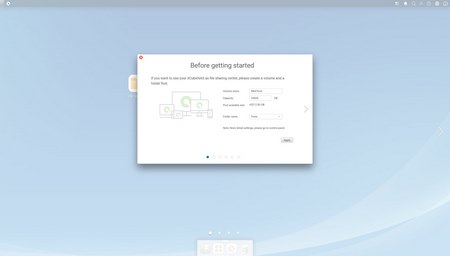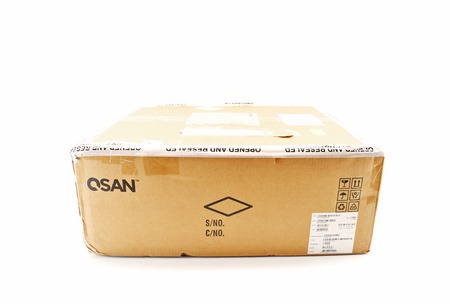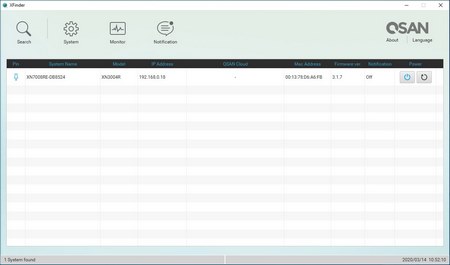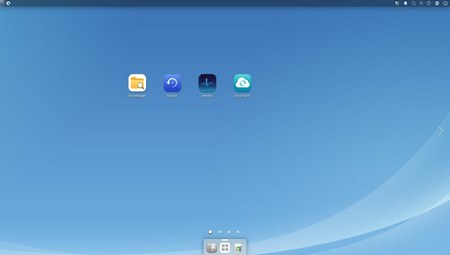INTRODUCTION

Largely thanks to their media playback capabilities, small space requirements and very low power consumption levels NAS (network attached storage) devices may have in large part replaced HTPCs and small download and web hosting servers but their main function has always been file storage and sharing (either locally or remotely). This is also what most small and large businesses are interested in so it does make sense that most rackmount models are focused primarily on that function by offering multiple network ports (of various speeds and types) and even expansion slots for extra network cards. The latest addition in the growing XCubeNAS family by QSAN is the 4-bay rackmount XN3004R model and it's also what we'll be focusing on today.
QSAN Technology, a leading storage technology designer and manufacturer, was founded in July 2004. Building on our vast experience in the industry, QSAN strives to build enterprise-class storage systems that pride ourselves with outstanding performance, secure data protection, and comprehensive data management. QSAN endeavors to provide the industry with high-quality data storage systems that are simple, secure, scalable and reliable. For more information, please visit www.QSAN.com.
The latest XN3004R model is a 4-bay (2.5/3.5"), 12 inch 1U rackmount NAS which QSAN markets as their all-in-one entry level storage solution aimed at small businesses and thus is not ideal for very heavy workloads. Still even though the XN3004R lacks PSU redundancy the 64-bit Intel Atom dual-core processor running at 1.6GHz which QSAN has paired with 4GB LPDDR3 RAM at 1600MHz (expandable to 8GB) and an 8GB flash DOM (disk on module) should provide adequate performance for up to medium workloads. The XN3004R also sports two USB 2.0 ports, two RJ45 Gigabit Ethernet ports, console port, single M.2 port and an PCIe Gen2x8 expansion slot which can be used with 10GbE RJ45 and SFP+ cards (models RHBE10R2 and XN-E1002). QSAN also covers the latest XCubeNAS XN3004R with a 3-year limited warranty.
SPECIFICATIONS AND FEATURES

PACKAGING AND CONTENTS
Just like with all their rackmount models the XCubeNAS XN3004R arrived inside a plain cardboard box that has the QSAN logo on all sides and a small sticker at the front on which you can see the included model, it's barcode and its serial number.
The NAS with its bundle is contained inside a 2nd box (the bundle is placed inside yet another cardboard box placed on top of two foam spacers).
Contained in the package are the rackmount rails with their screws, power cord, two yellow RJ45 Ethernet cables, two bags with 2.5" and 3.5" drive mounting screws, user manual and the XReplicator (backup software) license key.
THE XCUBENAS XN3004R EXTERIOR
The XCubeNAS XN3004R follows the 1U standard and measures 438mm in width, 370mm in length and 44mm in height.
QSAN has once again used their trademark color theme (lime green and black) at the front.

 Each drive tray has two activity LEDs (HDD/Power) and a locking switch at the front.
Each drive tray has two activity LEDs (HDD/Power) and a locking switch at the front.
On the far right of the fascia we find the power on/off and the unique identifier (UID) buttons/LED indicators.
A sticker showcasing the drive bay/slot sequence is placed right over the on/off button.
All 4 trays are made out of aluminum and plastic and can accommodate both 2.5" and 3.5" drives.



 Moving at the rear we find the power port, PSU exhaust fan, two RJ45 ethernet gigabit ports, two 40mm exhaust fans (the middle one is empty), UID LED, reset switch, mute button, two USB 2.0 ports, PCIe Gen2x8 expansion slot and the console port (primarily used for service access).
Moving at the rear we find the power port, PSU exhaust fan, two RJ45 ethernet gigabit ports, two 40mm exhaust fans (the middle one is empty), UID LED, reset switch, mute button, two USB 2.0 ports, PCIe Gen2x8 expansion slot and the console port (primarily used for service access).
THE XCUBENAS XN3004R INTERIOR
To access the interior of the XCubeNAS XN3004R you will first have to remove the side rail parts as seen above.
Almost all of the interior is taken by the mainboard, the PSU and of course the 4 drive bays.
The 200W PSU is manufactured by AC Bell.
A large silver heatsink is placed just over the dual-core Intel Atom CPU.
Our sample arrived with a single 4GB LPDDR3 1600MHz SO-DIMM by TLA.
The USB 2.0 8GB DOM flash module is manufactured by Innodisk.




On the board we also see the Lattice non-volatile PLD (programmable logic device), Marvell 88SE9235 SATA 6Gb/s host controller, Nuvoton voltage and temperature monitoring chip and the M.2 slot.


We tried using the M.2 slot with both M.2 SATA and M.2 NVMe SSDs without luck and after contacting QSAN we learned that this slot has only been certified for use with the Samsung SM951 (AHCI version) SSD so do keep that in mind if you intend on using it.
With 4 Seagate IronWolf 12TB drives installed we can now begin our tests of the XCubeNAS XN3004R.
SETUP
Using the XFinder software by QSAN simplifies the entire setup procedure since it detects the NAS on your local network (double click on the unit to launch your web browser).
If the NAS detects a new QSM OS version it will perform an automatic update prior to starting the setup procedure.
The setup wizard has two options, quick setup and customized setup (we always choose the latter).




 As with other NAS models you will need to enter a password, set the time and date, configure the network settings and choose the desired mode for the mounted drives (for our tests we start with RAID 0 followed by RAID 5).
As with other NAS models you will need to enter a password, set the time and date, configure the network settings and choose the desired mode for the mounted drives (for our tests we start with RAID 0 followed by RAID 5).



After this the NAS will boot and you will have to create a volume and a folder as seen above (QSAN also informs you of some of the other functions and features of their NAS).
QSM 3.2.2 PART 1
The QSM GUI has remained pretty much the same to date so nothing new on the main/start screen.


As with previous versions the restart/logout/shutdown commands are located in the upper left corner of the QSM OS while the system monitor can be accessed from the top right corner.
As expected from within the file manager app you can browse through all the files in the NAS, create/remove directories, copy files and much more.
Inside the backup app QSAN has placed several ways for you to back up your sensitive data either locally, remotely and even on the cloud.
You can monitor the current system load and hardware devices in general from within the monitor app.
With the Cloud Sync up syncing files between your NAS and your Cloud provider has never been easier (supports Google Drive, Microsoft OneDrive and DropBox).
QSAN says they will expand the number of available applications but for now at least we still see the same as with every previous NAS model of theirs.
The Web Server app allows you to get your very own site up and running (multiple ones via virtual host).
You can index all the multimedia files in the NAS by categories automatically via the Media Library Management app.
The anti-virus app provides extra protection for your files (however it's not enabled by default since it does use extra resources).
QSM 3.2.2 PART 2
Via the control panel you have access to a plethora of features and settings not only for the software but also the hardware aspect of the XCubeNAS XN3004R.
From within the system tab you can change the name of the system and the login password, adjust the time/date, enable auto logout (after X minutes) and login lock (single login), select the communications protocol, check the various network connections and enable link aggregation (if supported by your network setup), create static routes, use ping and trace route, adjust access control and setup the firewall, use an SSL certificate, enable the DDNS and UPNP services, configure notifications, set the power settings (like auto shutdown, hibernation and WOL), access the status of the UPS (if you have one attached to the NAS), check all logs, perform firmware updates (automatically or manually) and system recovery and finally you can import/export all of your NAS settings.
As expected, everything related to drives including the creation and deletion of volumes (remote volumes as well) and pools, drive information (IronWolf and IronWolf Pro drives enjoy a few health monitoring perks with QSAN NAS models) and SSD caching is placed under the Storage tab (since the M.2 slot was not compatible with our SSDs we didn't use SSD caching for our review).
Under the file sharing tab, you can add/remove users, create groups, enable domain security and of course create and delete shared folders.
The network service tab includes settings related to service binding, CIFS, AFP, NFS, FTP, WebDAV, Rsync, Bonjour and Time Machine.
TESTING METHODOLOGY
Originally, we had decided that since some of the NAS servers/devices we've tested in the past are no longer in our possession (naturally) we would keep performing the exact same testing methodology we did in the past for as long as possible in order to provide accurate comparison results. However, since our real-life tests are not enough for some people, we also decided to throw in ATTO V2.47 and Crystal Disk Mark V3.0.4 to cover the more demanding users. However as always we will be using a single Seagate Constellation ES.3 4TB SATA III and up to 10 Seagate IronWolf 12TB SATA III hard disk drives with 3.5” compatible units (we switched to 12TB models for RAID tests since August 2018 – due to high workloads the performance of previous drives had started to deteriorate) and up to two (for now) Enterprise Capacity 2.5 HDD V3 2TB SATA III HDDs with 2.5” compatible units to perform several upload/download tests with 10.9GB (Single) and 40,8GB (RAID) files. Tests are repeated a total of 4 times after which we record the average numbers (from the 4 peak ones) into our charts. The network device used for 1GbE tests is the same Netgear D7800 VDSL Modem/Router we’ve been using lately when performing tests on NAS servers.
* Since the 25th of June 2015 for 10GbE tests we’ll be using a Netgear ProSafe XS712T 10G Smart Switch and an Intel XT540-AT2 10GbE PCIe card (10GbE compatible NAS cards will be provided from each company and stated in each review).
** In May 2019 we also introduced TB3 (Thunderbolt 3) tests using our latest test rig (X299 AORUS GAMING 9 / INTEL CORE I9 7980XE / 64GB DDR4-3200 / GC-ALPINE RIDGE V2.0). For TB3 tests we'll be using ATTO V4.00.02F, Crystal Disk Mark V6.0.2 and Passmark Performance Test V9.1.
*** As of October 2019, we'll also be using the QNAP QSW-804-4C Ethernet Switch for 2.5/5G NAS reviews. The benchmarking programs used will be ATTO V4.01.0F1, Crystal Disk Mark V6.0.2 and several real-world upload/download tests with 30GB (Single Drive) and 60GB (Raid) files.
TEST RESULTS
SINGLE



RAID



TEST RESULTS – TEMPERATURES / CONSUMPTION / NOISE



CONCLUSION

Rackmount NAS models have two things going for them, endurance/durability (even more so when they have redundant power supplies – this of course translates to higher data integrity) and improved performance levels compared to their equivalent (same CPU/RAM combo) desktop counterparts. At the same time, they take more space (depends however on the where you plan to place your NAS), require more power (higher consumption) and are much louder. Still for professional/business use performance and endurance/durability are the two defining factors of any NAS model so these “downsides” don’t really matter (at least not to that target audience) and as you can tell from our charts the XCubeNAS XN3004R does quite good, for an Atom CPU based model that is. However, it’s also evident from our charts that in heavy workloads the performance of the XN3004R falls somewhat short so for really demanding users we’d have to recommend a model from the higher-end lines by QSAN (like the XN5004R). I also have no clue as to why QSAN decided to add an M.2 slot in the XN3004R when you practically can’t use it (unless that is you have the Samsung SM951 M.2 NVMe SSD or you plan on getting one). As for the limited applications this shouldn’t be a problem for business use, still since many of you have been asking from us to ask QSAN to expand them we sure hope they will eventually.
The XCubeNAS XN3004R model was released 5 months ago and currently retails for around USD700 inside the USA and for around 1400Euros inside the EU a price tag which although very appealing on the other side of the Atlantic just feels way off over here. Price aside the XCubeNAS XN3004R offers good performance with most of the features small businesses are looking for from an affordable NAS and that’s why it comes highly recommended by us, especially for USA residents.
PROS
- Excellent Build Quality
- Good Performance (For An Atom Based NAS)
- 4GB DDR3-1600 RAM (Expandable To 8GB)
- 2 RJ45 Gigabit Ethernet Ports (Link Aggregation Supported)
- PCIe Slot (PCIe Gen2x4)
- 4 Drive Bays (3.5”/2.5”)
- Power Consumption (For A Rackmount Model)
- Drive Temperatures
- XReplicator Software
- RAID 0/1/5/5 + hot spare/6/Z3/10/50/60/JBOD
- QSM 3.2 OS
- Price (USA)
CONS
- Price (EU)
- Overall Performance (Compared To Higher End Models)
- USB 2.0 Ports
- M.2 Slot Compatibility
- Limited Apps (Both NAS And Mobile)
- Noise Levels

 O-Sense
O-Sense




































































.png)

